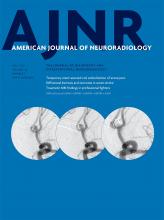Research ArticleAdult Brain
Open Access
APOE*E4 Is Associated with Gray Matter Loss in the Posterior Cingulate Cortex in Healthy Elderly Controls Subsequently Developing Subtle Cognitive Decline
S. Haller, M.-L. Montandon, C. Rodriguez, M. Ackermann, F.R. Herrmann and P. Giannakopoulos
American Journal of Neuroradiology July 2017, 38 (7) 1335-1342; DOI: https://doi.org/10.3174/ajnr.A5184
S. Haller
aFrom the Affidea Centre de Diagnostic Radiologique de Carouge (S.H.), Geneva, Switzerland
bFaculty of Medicine (S.H., M.-L.M., F.R.H., P.G.), University of Geneva, Switzerland
cDepartments of Surgical Sciences and Radiology (S.H.), Uppsala University, Uppsala, Sweden
dDepartment of Neuroradiology (S.H.), University Hospital Freiburg, Freiburg, Germany
M.-L. Montandon
bFaculty of Medicine (S.H., M.-L.M., F.R.H., P.G.), University of Geneva, Switzerland
eDepartment of Mental Health and Psychiatry (M.-L.M., M.A.)
C. Rodriguez
fDivision of Institutional Measures, Medical Direction (C.R., P.G.)
M. Ackermann
eDepartment of Mental Health and Psychiatry (M.-L.M., M.A.)
F.R. Herrmann
bFaculty of Medicine (S.H., M.-L.M., F.R.H., P.G.), University of Geneva, Switzerland
gDivision of Geriatrics, Department of Internal Medicine, Rehabilitation and Geriatrics (F.R.H.), University Hospitals of Geneva, Geneva, Switzerland.
P. Giannakopoulos
bFaculty of Medicine (S.H., M.-L.M., F.R.H., P.G.), University of Geneva, Switzerland
fDivision of Institutional Measures, Medical Direction (C.R., P.G.)

References
- 1.↵
- Corder EH,
- Saunders AM,
- Strittmatter WJ, et al
- 2.↵
- Strittmatter WJ,
- Saunders AM,
- Schmechel D, et al
- 3.↵
- 4.↵
- Jack CR Jr.,
- Wiste HJ,
- Weigand SD, et al
- 5.↵
- Lee YM,
- Ha JK,
- Park JM, et al
- 6.↵
- 7.↵
- 8.↵
- 9.↵
- 10.↵
- Honea RA,
- Vidoni E,
- Harsha A, et al
- 11.↵
- Agosta F,
- Vossel KA,
- Miller BL, et al
- 12.↵
- Wishart HA,
- Saykin AJ,
- McAllister TW, et al
- 13.↵
- 14.↵
- Liu Y,
- Paajanen T,
- Westman E, et al
- 15.↵
- 16.↵
- 17.↵
- 18.↵
- 19.↵
- 20.↵
- Habes M,
- Toledo JB,
- Resnick SM, et al
- 21.↵
- 22.↵
- Shaw P,
- Lerch JP,
- Pruessner JC, et al
- 23.↵
- 24.↵
- 25.↵
- Risacher SL,
- Shen L,
- West JD, et al
- 26.↵
- Folstein MF,
- Folstein SE,
- McHugh PR
- 27.↵
- Zigmond AS,
- Snaith RP
- 28.↵
- Barberger-Gateau P,
- Commenges D,
- Gagnon M, et al
- 29.↵
- Wechsler DA
- 30.↵
- Reitan RM
- 31.↵
- Wechsler D
- 32.↵
- Milner B
- 33.↵
- Buschke H,
- Sliwinski MJ,
- Kuslansky G, et al
- 34.↵
- Baddley A,
- Emslie H,
- Nimmo-Smith I
- 35.↵
- Kaplan EF,
- Goodglass H,
- Weintraub S
- 36.↵
- Schnider A,
- Hanlon RE,
- Alexander DN, et al
- 37.↵
- Roy EA
- Poeck K
- 38.↵
- Welsh KA,
- Butters N,
- Mohs RC, et al
- 39.↵
- Hughes CP,
- Berg L,
- Danziger WL, et al
- 40.↵
- Petersen RC,
- Doody R,
- Kurz A, et al
- 41.↵
- 42.↵
- Nauck M,
- Hoffmann MM,
- Wieland H, et al
- 43.↵
- Smith SM,
- Nichols TE
- 44.↵
- 45.↵
- Teipel S,
- Grothe MJ
- 46.↵
- Chételat G,
- Ossenkoppele R,
- Villemagne VL, et al
- 47.↵
- 48.↵
- 49.↵
- 50.↵
- Albert MS,
- DeKosky ST,
- Dickson D, et al
In this issue
American Journal of Neuroradiology
Vol. 38, Issue 7
1 Jul 2017
Advertisement
S. Haller, M.-L. Montandon, C. Rodriguez, M. Ackermann, F.R. Herrmann, P. Giannakopoulos
APOE*E4 Is Associated with Gray Matter Loss in the Posterior Cingulate Cortex in Healthy Elderly Controls Subsequently Developing Subtle Cognitive Decline
American Journal of Neuroradiology Jul 2017, 38 (7) 1335-1342; DOI: 10.3174/ajnr.A5184
0 Responses
APOE*E4 Is Associated with Gray Matter Loss in the Posterior Cingulate Cortex in Healthy Elderly Controls Subsequently Developing Subtle Cognitive Decline
S. Haller, M.-L. Montandon, C. Rodriguez, M. Ackermann, F.R. Herrmann, P. Giannakopoulos
American Journal of Neuroradiology Jul 2017, 38 (7) 1335-1342; DOI: 10.3174/ajnr.A5184
Jump to section
Related Articles
Cited By...
- The impact of APOE {varepsilon}4 in Alzheimers disease: a meta-analysis of voxel-based morphometry studies
- Absolute Winding Number Differentiates Spatial Navigation Strategies with Genetic Risk for Alzheimers Disease
- Apolipoprotein E genotype and MRI-detected brain alterations pertaining to neurodegeneration: A systematic review
- Brain Perfusion Measurements Using Multidelay Arterial Spin-Labeling Are Systematically Biased by the Number of Delays
- Atypical Localization and Dissociation between Glucose Uptake and Amyloid Deposition in Cognitively Normal APOE*E4 Homozygotic Elders Compared with Patients with Late-Onset Alzheimers Disease
This article has not yet been cited by articles in journals that are participating in Crossref Cited-by Linking.
More in this TOC Section
Similar Articles
Advertisement











